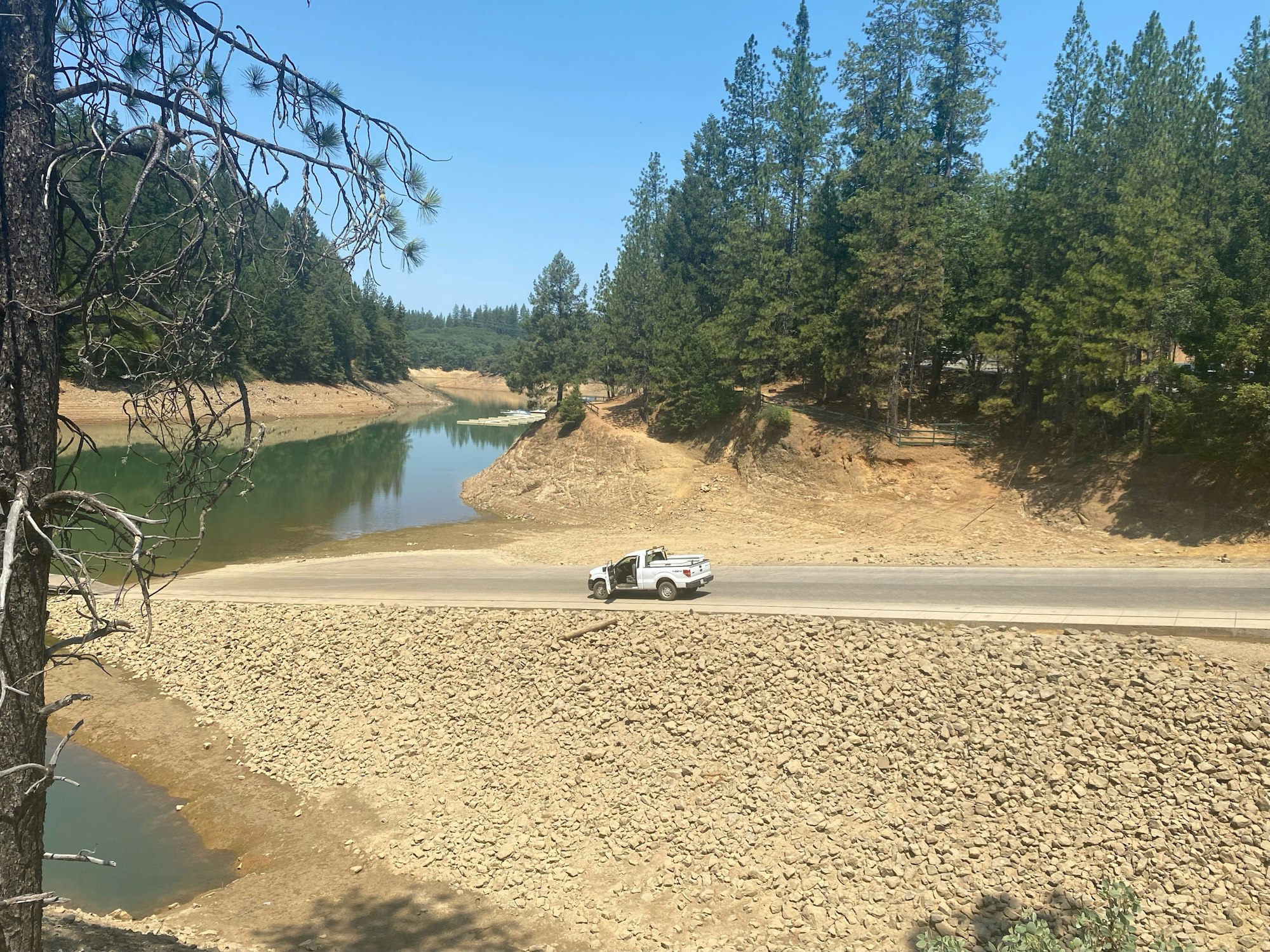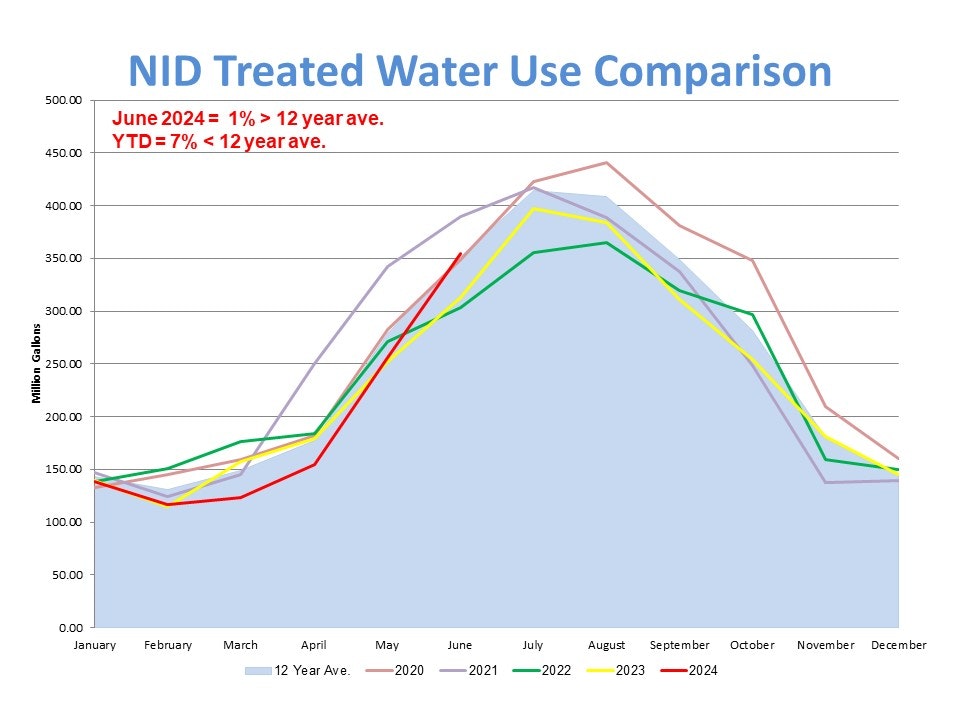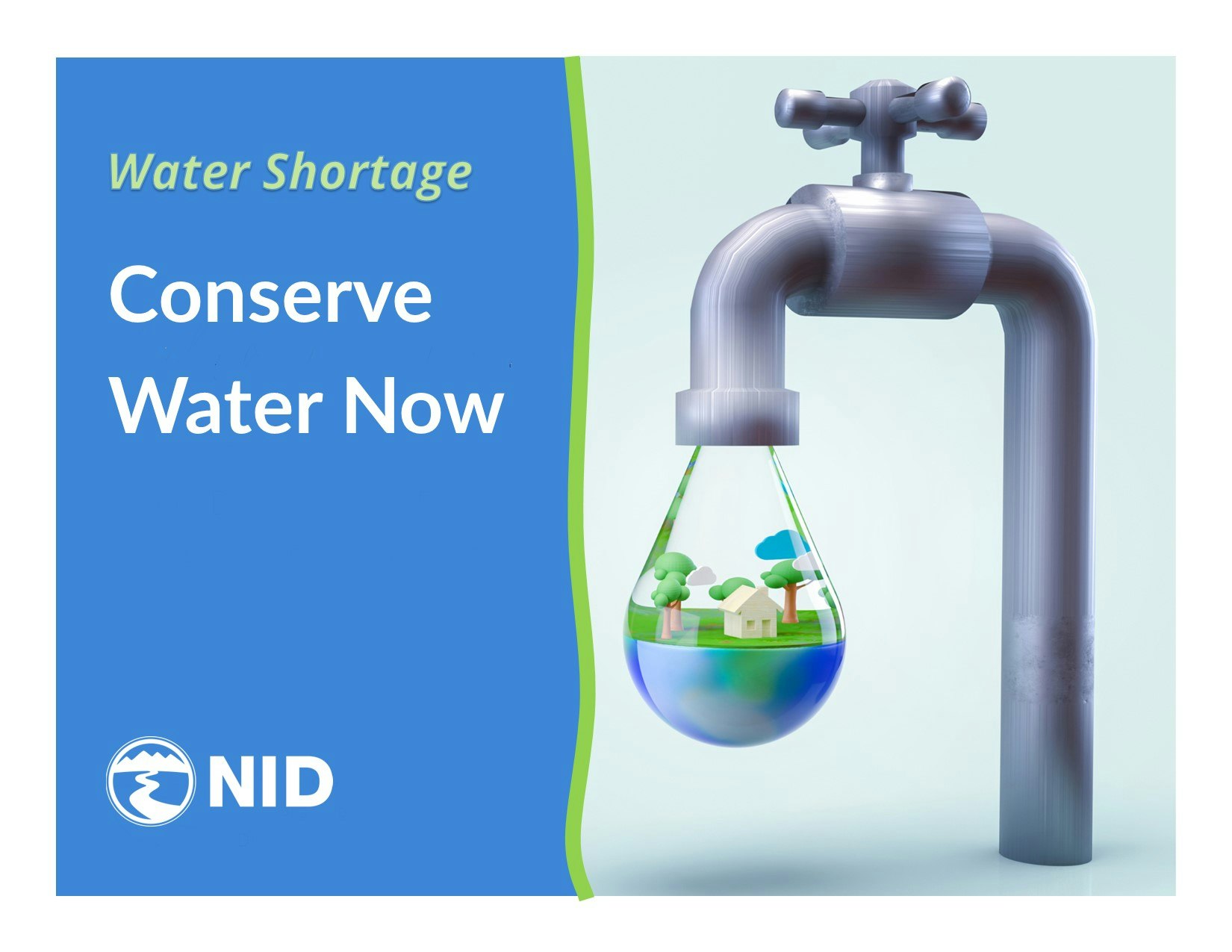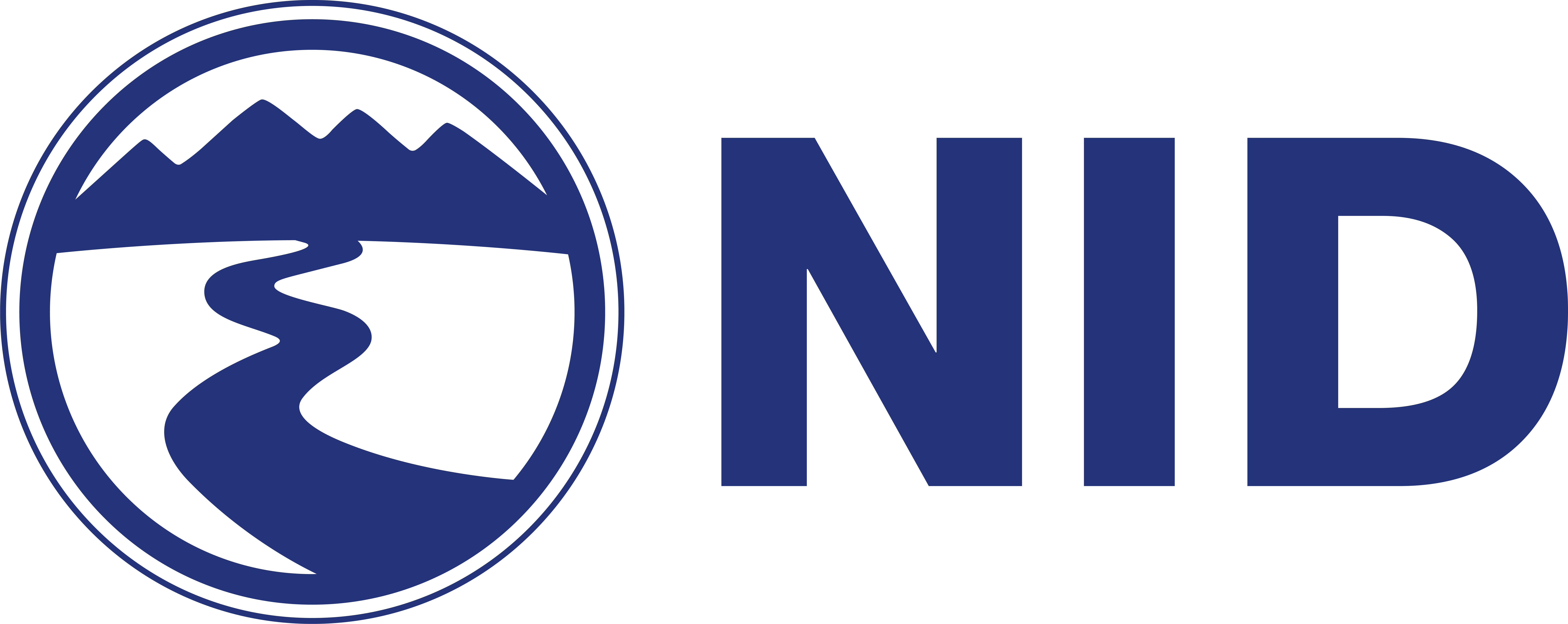2024 Emergency Water Shortage is Real
Reservoir levels are dangerously low; conservation is the only way to protect water supply

A statewide water organization recently published the story “NID Faces Dry Summer After Wet Winter,” alerting its public agency members about the emergency water shortage: “The Nevada Irrigation District (NID) is conserving like it’s 2022, as if the last two wet winters never happened while water levels at two of its reservoirs plummet toward the halfway mark,” wrote the Association of California Water Agencies.
As unusual as our local emergency water shortage is, it is real. The situation has nothing to do with drought or NID’s overall water supply. The district entered this year with above-average reservoir storage with ample Sierra Nevada snowpack to provide its source water.
The issue is severe damage to infrastructure high up at Lake Spaulding, which is owned by the Pacific Gas and Electric Company (PG&E). Until that damage is repaired, no water can flow into NID’s primary conveyance canals that bring water down to the foothills. As a result, the district has been entirely reliant on a limited supply of stored water in Rollins and Scotts Flat reservoirs. Since spring, NID has been drawing down the reservoirs to supply irrigation- and treated water customers. The water from Scotts Flat serves the greater Nevada County communities while Rollins Reservoir provides water to NID’s Placer County customers.
Now, water levels of these reservoirs are dropping dramatically. Rollins only had 40 percent of available capacity for consumptive use, and Scotts Flat was at 56 percent of usable capacity, as of July 19.
“This is a difficult situation for customers and our community to grasp, because we aren’t in a drought, and yet there are dramatic drops in reservoir levels,” said NID Assistant Manager Greg Jones. “Now, the community can see the direct correlation between reservoir levels and water use as our supply is vanishing in front of our eyes. That is a wake-up call of how finite and limited the supply is.”
Wise water use makes a difference
Generally, NID’s water distribution is 80 percent to raw water customers for irrigation of fields and farms, 10 percent to treated water customers for drinking water and household use, and 10 percent for environmental flows to rivers and streams.
Against the backdrop of the emergency water shortage, NID has called on customers to conserve water. After earlier voluntary efforts fell short of expectations, on June 27 the district’s Board of Directors established mandatory conservation measures in response to an extended timeline for PG&E infrastructure repairs. The conservation goal is to achieve a 20 percent reduction in water use as compared to 2023.
Raw water used for irrigation

Today, NID has about 5,400 raw water customers who irrigate more than 32,000 acres in Nevada and Placer counties. They contribute to the agriculture economies in Placer County worth $89 million and Nevada County worth $19 million in 2022.
Farmers and ranchers have been enduring the brunt of the water shortage, and many have reduced operations and types of crops they are growing this year. Heeding the call for voluntary efforts, 276 customers adjusted their water purchases for a reduction of 453 miner’s inches, which is equivalent to 4,111 acre-feet.
More demand reduction was needed, however; and in July rotating outages have been necessary on a handful of canals. Water was temporarily cut off on a three-day rotation beginning on July 11, and the outages will end on July 23.
“We appreciate the early efforts of our customers to voluntarily reduce demand, however as the summer heat set in and evaporation rates have increased, we have been compelled to implement stricter measures to ensure supplies last through the irrigation season. The District has exhausted all available measures to help minimize the impact on customers. It is now necessary to implement these rotating water outages for a limited number of canals until water supply is restored,” Jones said.
Treated water customers lag with conservation efforts
NID provides treated water for drinking and household use to more than 21,000 customer connections. When the request for voluntary conservation was made in late March, customers began cutting back, and in May they were using 8 percent less than average.
However, facing weeks of unrelenting summer heat, treated water use has increased. In June, the conservation savings were gone, and customers actually used 1 percent more water than the recent twelve-year average.


As we watch the reservoir levels drop, the push for water efficiency continues. NID’s mandatory measures include a three-day watering schedule and commonsense measures.
Both treated- and raw water customers are limited to a three-day watering schedule. This applies to the watering of lawns, ornamental landscape, and turf. Here’s the schedule:
- Odd property addresses are permitted to water turf on Tuesday, Thursday and Saturday
- Even property addresses are permitted to water turf on Wednesday, Friday, and Sunday.
All watering of lawns, ornamental landscaping and turf needs to be done in early morning (before 7 a.m.) and late evening (after 9 p.m.).
Commonsense water use includes:
- Keep water on your property: no runoff is allowed from watering that flows onto adjacent property, walkways, roadways, parking lots, and the like
- Put a nozzle on it: when you wash your car, the hose must be fitted with a spray nozzle or attached device that cuts off water when not in use
- No fake water features: don’t fill a fountain or other decorative water feature, except where the water is part of a recirculating system
- Ask for a glass of water: drinking water won’t be automatically poured in eating or drinking establishments. Thirsty? Not a problem; water is available upon request
- Traveling? Forego daily washed towels and sheets: hotel and motel operators will provide guests with the option of not having towels and linens laundered daily. Choose to save water by not having washable items changed every 24 hours.
Environmental flows continue
An environmental instream flow is water that is managed and released from a dam to maintain downstream river health, habitats and watersheds. These flows are regulated by state agencies and must be maintained accordingly.
NID provides environmental flows from Rollins Reservoir into the Bear River. And, even though a water shortage emergency has been declared, these flows remain.
Timing of repairs so flows can begin
PG&E has completed repairs at Powerhouse #1 and #2, and is currently testing flows. Repairs to the South Yuba Pipe have been extended from the end of August to the second week of September due to prioritization of helicopter resource requirements fighting wildfires in other areas. Until repairs are completed and tested, full water flows to NID’s Rollins and Scotts Flat reservoirs cannot occur.
Here’s the background:
The most upper segments of the South Yuba Pipe and Drum Canal are owned by PG&E and are operated in coordination with NID’s water storage and distribution facilities. These include the primary conduits for conveying water to NID lower elevation reservoirs, Scotts Flat and Rollins reservoirs.
To visualize how this system works, think of an hourglass with its two pear-shaped bulbs at top and bottom with a very narrow passage formed in between. The upper bulb is the Sierra snowmelt at and above Lake Spaulding. The narrow passage is PG&E’s damaged powerhouse facilities emptying into the lower bulb, representing the district’s customers and distribution system inclusive of Rollins and Scotts Flat reservoirs. Until water can flow through the narrow passage, the bottom bulb is effectively cut off.
In early February, about 240 feet of PG&E’s South Yuba Pipe, extending from Powerhouse #2 at Lake Spaulding, was damaged in a winter storm rockslide. The pipe carries water from the Spaulding #2 powerhouse to NID’s South Yuba Canal, conveying water into Deer Creek and ultimately Scotts Flat Reservoir, which in turn supplies the greater Nevada County communities.
In addition, PG&E's Spaulding #1 Powerhouse has been offline since early March, following the discovery of a leak and subsequent damage. This has rendered inoperable the Drum Canal, which is the primary source of water for the Bear River system and Rollins Reservoir.
Resumed flows: it will take time to replenish reservoirs
Once PG&E repairs are completed and tested, partial flows will resume to the Drum and South Yuba canals.
“PG&E has begun testing repairs to the Spaulding #1 powerhouse. Once flows are resumed, estimated on July 30, we anticipate Rollins will slow its drawdown. In other words, there will not be enough flows to begin refilling the reservoir until fall/winter storms” said Chip Close, Director of Water Operations.
“Scotts Flat will continue its drawdown until the South Yuba Canal is fully operational after that date the reservoir drawdown will be reduced,” he said.
Call for wise water use
In short, the emergency water shortage is real. NID asks everyone in our community to look at the shockingly shrinking water levels in Rollins and Scotts Flat reservoirs and do their part to save water.
“In this unprecedented situation, the district appreciates everyone’s support in finding ways to be absolutely efficient with water use. It does make a difference,” Jones said.
(July 2024)
